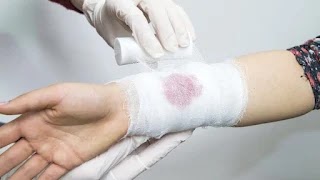Open wounds can pose significant risks if not handled correctly. Discover three straightforward methods for stopping bleeding and effectively dressing open wounds here.
An open wound is an injury that breaches the skin, resulting in blood loss. These wounds can occur due to scrapes, cuts, burns, or punctures from sharp objects. Failing to promptly address an open wound can be perilous, potentially leading to infections, shock, or even fatality.
Therefore, it's crucial to know how to properly dress an open wound as a first aid measure. You can perform these wound dressing steps either on your own or with the assistance of others. Here are the steps:
1. Apply Pressure to Stop Bleeding
The initial step you should take is to apply pressure to the wound using tissues, clean cloth, sterile gauze, or any material capable of absorbing blood. The objective is to halt or reduce the flow of blood from the wound.
You can use your hand or employ a bandage if available. If the blood soaks through and wets the tissue or cloth you are using, do not replace it with a new one. Instead, add more material on top and increase the pressure.
If the open wound is on an elevated body part, like the hand or foot, raise that part above the level of your heart to decrease blood flow to the wound.
2. Clean and Disinfect the Wound
After successfully stopping or reducing the bleeding, the next step is to clean and disinfect the wound using clean water and antiseptic soap. The aim is to remove dirt, dust, or bacteria that might lead to an infection.
You can clean the wound by either gently pouring running water over it or immersing it in clean water. Then, use antiseptic soap to gently clean the skin around the wound. Avoid touching or rubbing the wound directly.
Following this, rinse the wound again with clean water until all the soap is removed. Dry the wound by patting it with a clean cloth or sterile gauze. Refrain from rubbing or drying the wound in any other manner.
3. Cover and Secure the Wound
The final step involves covering and securing the wound with a bandage or dressing appropriate for the type and size of the wound. The purpose is to shield the wound from contamination and friction, which could worsen the wound.
You can use sterile gauze, adhesive bandages, elastic bandages, or any material that can effectively cover the wound. Ensure that you do not touch the inner part of the wound dressing that will come into direct contact with the wound.
Place the wound dressing over the wound and secure it with ties or adhesive. Avoid making it too tight or too loose. Replace the wound dressing every 6-12 hours or if it becomes soiled.
These are the three simple techniques for stopping bleeding and properly dressing an open wound. If you encounter a large, deep, or heavily bleeding open wound, seek immediate medical attention for further treatment.
(Source)














0 Comments